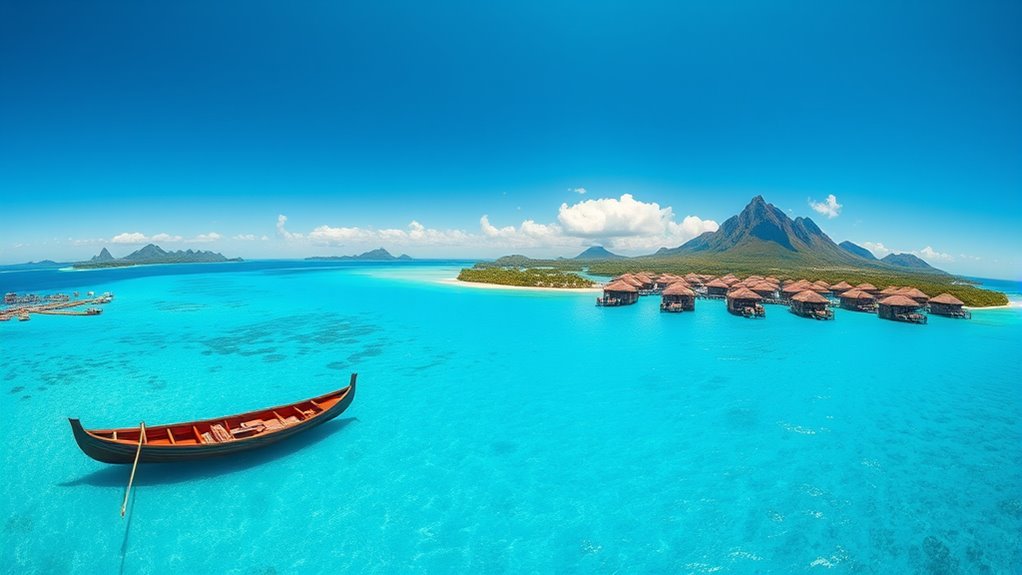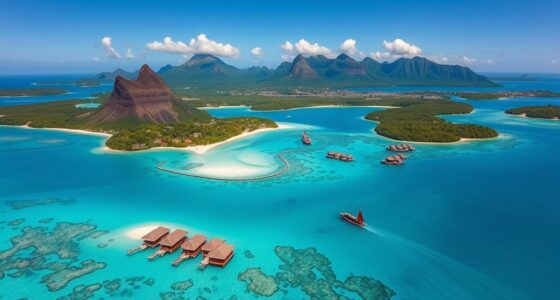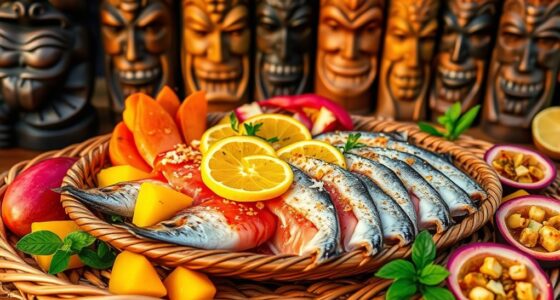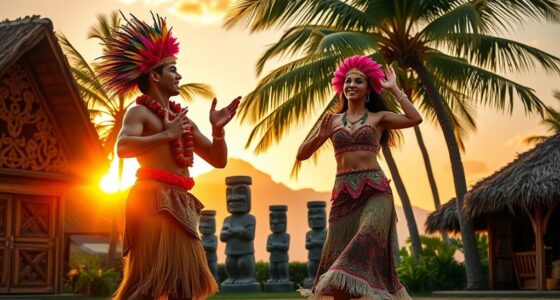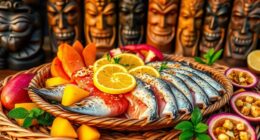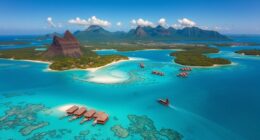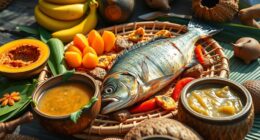Discover Polynesia’s top attractions by exploring its iconic volcanic peaks like Bora Bora’s rugged mountains and Tahiti’s Mont Orohena. Relax on pristine beaches such as Matira Beach and enjoy vibrant lagoons perfect for snorkeling and kayaking. Immerse yourself in rich cultural sites like Taputapuatea marae and ancient tiki statues. The islands’ volcanic landscapes and preserved ecosystems create unforgettable scenery. Keep exploring to uncover all the breathtaking sights and hidden gems this stunning region has to offer.
Key Takeaways
- Rugged volcanic peaks and crater landscapes across islands like Bora Bora, Tahiti, and Moorea.
- Pristine beaches and vibrant lagoons perfect for snorkeling, swimming, and relaxation.
- Ancient Polynesian cultural sites such as Taputapuatea marae and tiki statues.
- Unique geological features, including volcanic craters and peaks shaping the islands’ scenery.
- Diverse ecosystems with coral gardens, natural pools, and protected marine habitats.
Iconic Islands and Volcanic Peaks
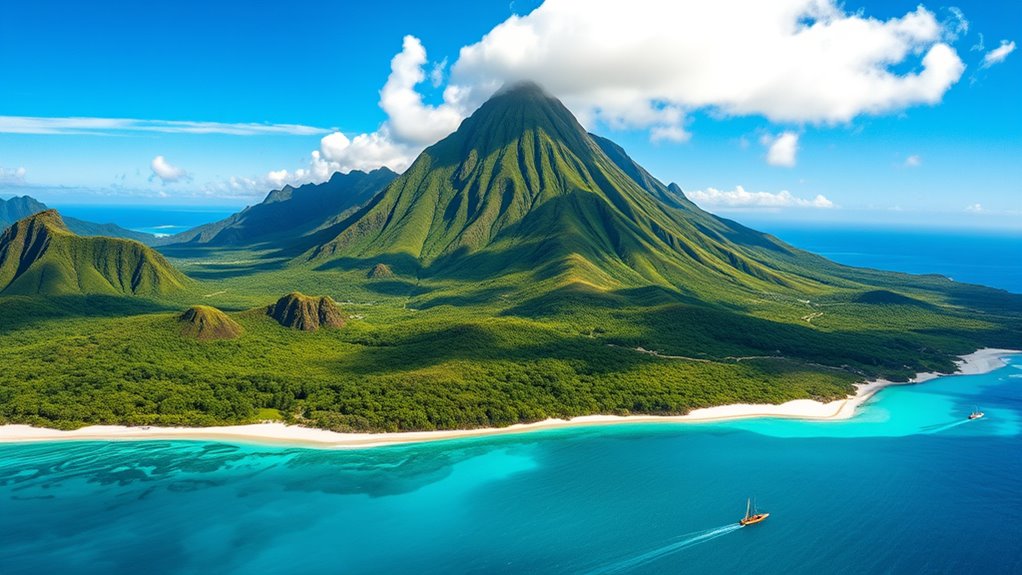
Polynesia is renowned for its stunning volcanic islands and dramatic peaks that define its landscape. You’ll be captivated by islands like Bora Bora, where rugged volcanic peaks rise sharply from turquoise lagoons, creating a breathtaking backdrop. Tahiti’s Mont Orohena stands as French Polynesia’s highest point, offering challenging hikes and panoramic views. Moorea boasts twin volcanic peaks, Mount Mou’a and Mount Tohivea, framing lush valleys and white-sand beaches. Maupiti, a smaller volcanic island, offers dramatic hikes to viewpoints overlooking a tranquil lagoon. These islands showcase the raw power of volcanic activity, shaping the islands’ geography and offering striking scenery at every turn. Whether you’re gazing at towering peaks or exploring volcanic craters, these geological marvels are the heart of Polynesia’s island charm.
Pristine Beaches and Vibrant Lagoons
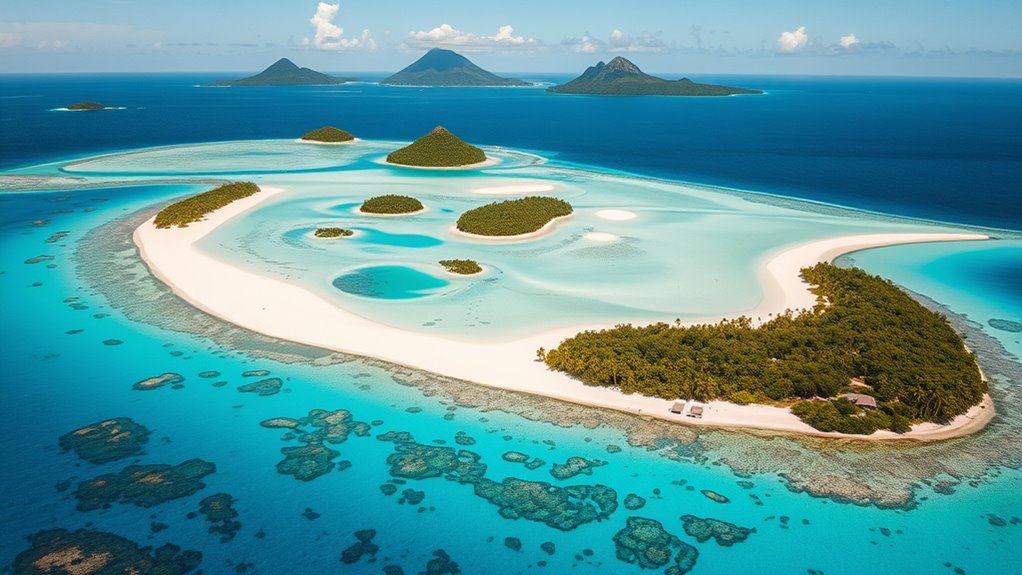
The islands’ volcanic origins have created some of the world’s most breathtaking beaches and lagoons. You’ll find powdery white sands at Matira Beach in Bora Bora, perfect for relaxing or swimming in shallow, calm waters. Moorea’s Haapiti Lagoon offers warm, shallow spots ideal for paddleboarding, kayaking, and spotting marine life close to shore. On Fakarava, the untouched Pk 9 Beach features crystal-clear waters backed by leaning palms, embodying pristine atoll beauty. Motu Tiahura in Moorea provides vibrant snorkeling at sunset, with coral gardens teeming with colorful fish. Rangiroa’s Ile aux Récifs boasts coral gardens and natural pools, offering peaceful, paradise-like settings. These beaches and lagoons invite you to swim, snorkel, or simply soak in their untouched natural beauty. Self Watering Plant Pots are an example of how innovative design helps maintain the natural balance of ecosystems, similar to how these pristine environments sustain diverse marine life.
Cultural Heritage and Ancient Sites

Have you ever wondered how ancient Polynesian societies left their mark on these islands? You can explore remarkable archaeological sites like marae, traditional stone temples essential to Polynesian culture. In Raiatea, the Taputapuatea marae is a UNESCO World Heritage site, showcasing centuries-old religious and ceremonial practices. On the Marquesas Islands, you’ll find tiki statues and petroglyphs that reveal the spiritual beliefs and artistry of early inhabitants. Visiting pearl farms on Fakarava or Tahiti offers insight into traditional craftsmanship and sustainable practices. These sites connect you to Polynesia’s rich history, allowing you to experience centuries-old rituals and stories firsthand. Walking through these ancient sites gives you a tangible link to the ancestors who shaped Polynesian culture and identity.
Frequently Asked Questions
What Are the Best Times of Year to Visit Polynesia?
You should visit Polynesia during its dry season, from May to October, when the weather is sunny, rainfall is minimal, and trade winds keep the temperatures comfortable. This is ideal for outdoor activities like snorkeling, hiking, and lounging on beaches. The shoulder months of April and November can also be good, offering fewer crowds and still decent weather. Avoid the cyclone season from November to April for safer, more enjoyable travel.
Are There Any Travel Restrictions or Visa Requirements?
Are you wondering if travel restrictions or visa requirements could tie you down? Right now, many Polynesian islands welcome visitors with minimal entry rules, but you’ll need a valid passport, and some islands may ask for a visa depending on your nationality. Always check the latest guidelines before you go, as rules can change. Have your travel documents ready to enjoy your island escape without a hitch!
What Local Customs Should Tourists Respect?
You should respect local customs by greeting locals with a warm “Ia Orana” and showing genuine politeness. Dress modestly, especially when visiting cultural sites or villages. Always ask permission before taking photos of people or their property, and avoid touching sacred objects. Be environmentally conscious by not littering or damaging coral reefs. Learning a few Polynesian words and embracing the relaxed, friendly vibe shows respect and helps you connect authentically with the community.
How Do I Book Luxury Overwater Bungalow Stays?
You can book luxury overwater bungalows by visiting the resort’s official website or contacting their reservation team directly. Many high-end resorts like those in Bora Bora and Moorea offer online booking options, but calling can sometimes secure better deals or specific preferences. Consider booking well in advance, especially during peak seasons, and check for package deals or special offers that include excursions or amenities to enhance your stay.
What Unique Polynesian Foods Should I Try?
Trying Polynesian foods is like discovering hidden treasures in every bite. You should definitely taste poisson cru, fresh raw fish marinated in coconut milk and lime—it’s a invigorating, tangy delight. Don’t miss mahi-mahi grilled with local spices or taro root cooked in banana leaves for earthy richness. For a sweet finish, try breadfruit pudding or tropical fruits like mango and papaya. These dishes capture the vibrant flavors and cultural soul of Polynesia.
Conclusion
Imagine standing on a island, feeling the warm sun and hearing the gentle waves—it’s like stepping into a living postcard. With over 1,000 islands in Polynesia, each offers a unique adventure, blending natural wonders with rich cultural stories. Just like a pearl forms over time, your unforgettable journey here will be shaped by vibrant lagoons, ancient sites, and breathtaking peaks. Polynesia isn’t just a destination; it’s a treasure chest waiting to be explored.

